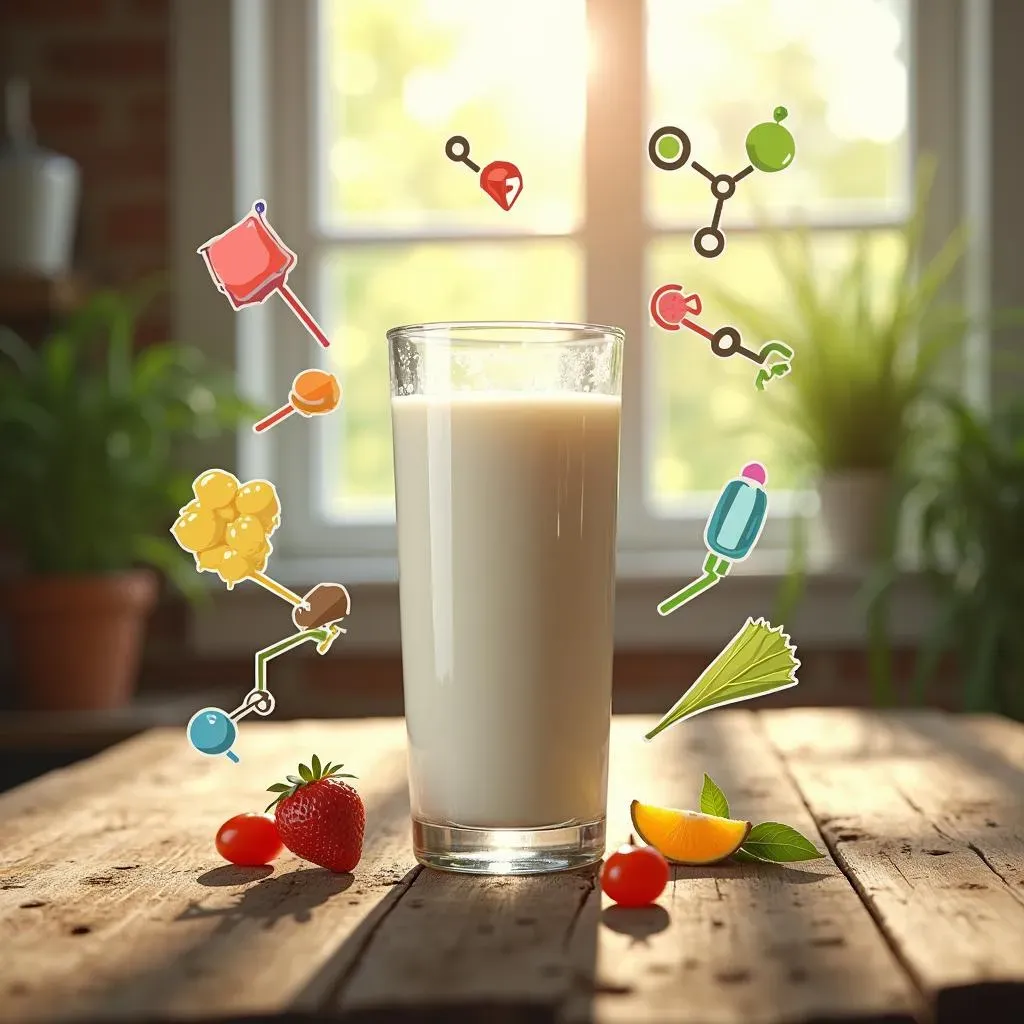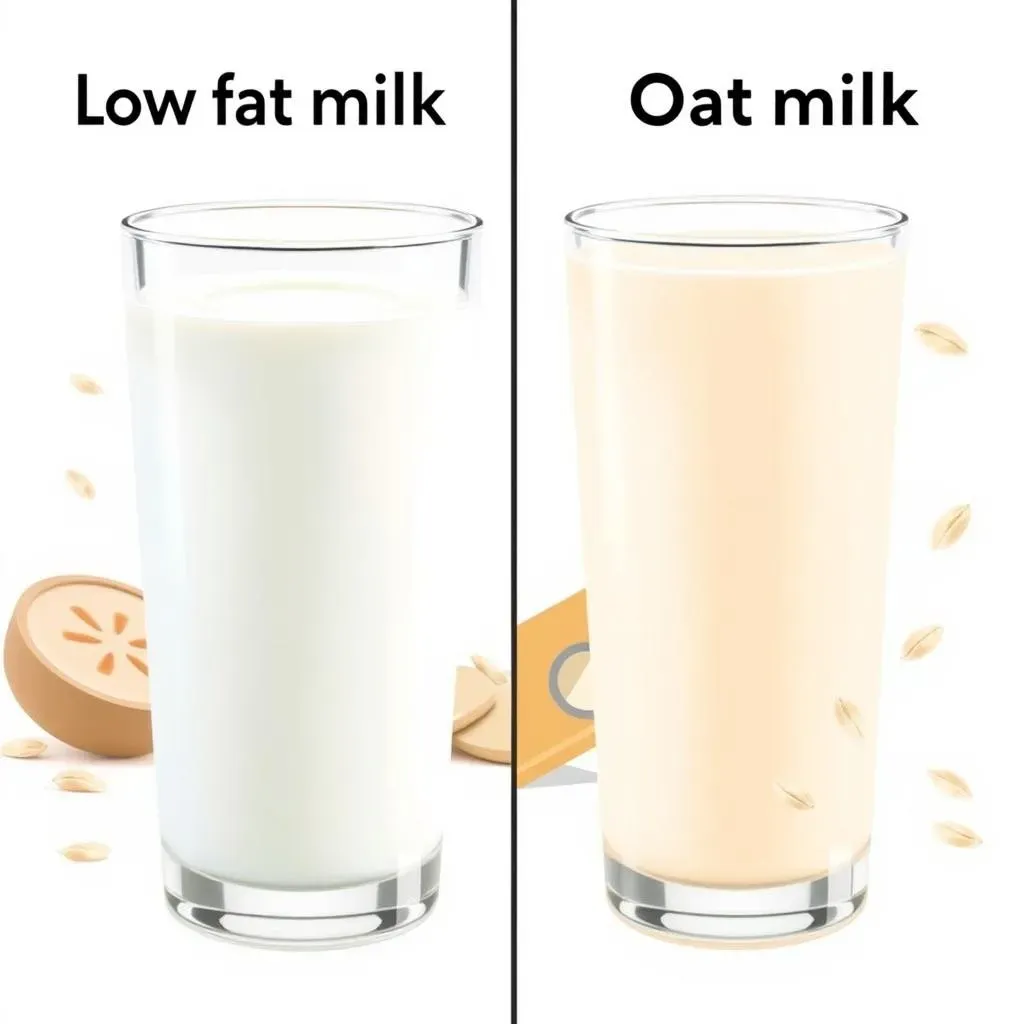Table of Contents
So, you're standing in the dairy aisle, right? It's a battle zone of cartons and claims. You've got your classic low fat milk, the old faithful, and then there's oat milk, the new kid on the block, all trendy and smooth. But which one is actually better for you? That's the big question we're tackling today. We're not just going to throw out some random facts. Instead, we will be breaking down the real deal about low fat milk vs oat milk. Think of this as your cheat sheet to the milk aisle. We'll check out what each one packs nutritionally. We'll see what's actually inside and how they stack up against each other. We'll also talk about the health benefits of each, you know, the stuff that actually matters. Get ready to ditch the confusion and make an informed choice about what you're pouring into your morning cereal. Let's get started!
Real Dairy Milk: The Nutritional Powerhouse

Real Dairy Milk: The Nutritional Powerhouse
The Basics of Dairy Milk
Alright, let's talk about real dairy milk. I mean, the stuff that comes from cows. It's been a staple for ages, right? It’s not just some random liquid; it’s packed with good things, like 13 essential nutrients in every glass. Think of it as a natural multivitamin, but way more delicious. We're talking about calcium for strong bones, protein to build muscles, and vitamins that help your body work right. And unlike some of the other milk options out there, it’s not pumped full of extras. It's just good, simple, and naturally nutrient-rich. It's like, the original superfood, if you ask me.
Now, when I say "real dairy milk," I mean the whole range, from whole milk to low-fat and skim. Each one has a slightly different fat content, but the core nutritional benefits are pretty consistent. It’s a complete protein source, meaning it has all the essential amino acids your body can’t make on its own. That's a big deal. Plus, it's super easy to find, and it usually doesn't cost a fortune. For me, it's the go-to choice when I need a nutrient boost. I remember when I was a kid, my mom always said milk was the best for growing up strong, and you know what? She was right!
Protein and More
Let's zoom in on the protein part. One 8-ounce glass of dairy milk packs about 8 grams of protein. That's double what you'd typically get from the same amount of oat milk. And not all protein is created equal. Dairy milk has high-quality protein, meaning it’s easily used by your body. This is super important for muscle repair and growth, especially if you’re active. It's like giving your body the best building blocks it needs.
Beyond protein, real dairy milk is also a good source of Vitamin D, which helps your body absorb all that calcium. It contains potassium, which is important for heart health and regulating blood pressure, plus, other vitamins like B12 and riboflavin. It’s like a symphony of nutrients all working together. I always tell people, if you want a simple, effective way to get a bunch of good stuff, it’s hard to beat a glass of good old dairy milk.
Nutrient | Amount per 8oz Glass (Dairy Milk) |
|---|---|
Protein | 8 grams |
Calcium | 300 mg |
Vitamin D | 100 IU |
Potassium | 350 mg |
Oat Milk: Examining the Ingredients and Nutrients

Oat Milk: Examining the Ingredients and Nutrients
The Scoop on Oat Milk
Okay, let's switch gears and talk about oat milk. It's become super popular, right? You see it everywhere, from coffee shops to grocery stores. But what exactly is it? Well, it's basically made by blending oats with water and then straining out the solids. Sounds simple enough, but the ingredient list can actually vary quite a bit depending on the brand. Some versions have added sugars, oils, gums, and even vitamins and minerals to boost their nutritional profile. It's like a science experiment in a carton, sometimes. So, when you pick up a carton of oat milk, it's worth taking a peek at the label to see what's actually in there.
Unlike dairy milk, oat milk is not naturally packed with nutrients. The vitamins and minerals you see listed are usually added in. That's not necessarily a bad thing, but it's important to know. The base of oat milk, the oats themselves, do offer some fiber. However, the amount of fiber is often reduced during the processing. Also, be aware that oat milk is naturally higher in carbohydrates compared to dairy milk. For example, a serving of original oat milk can have around 24 grams of carbs, while dairy milk has around 12 grams. So, if you're watching your carb intake, it's something to keep in mind. I always say, knowledge is power, especially when you're navigating the world of milk alternatives.
Nutrients and Fortification
When we talk about the nutrients in oat milk, it's important to realize that they aren't naturally occurring like in dairy milk. Manufacturers often fortify it with vitamins and minerals to make it more nutritionally comparable. This usually includes things like Vitamin D, Vitamin B12, and calcium. The amounts can vary widely among brands, so it's a good idea to check those labels. It’s a bit like comparing a naturally sunny day with a day where someone puts up a really good sun lamp. Both give you light, but one is more natural.
One area where oat milk stands out is in its fiber content, though this is often lower than what you'd find in whole oats. It can contain around 2 grams of fiber per serving, which is more than what you'll find in dairy milk. Fiber is great for digestion and can help keep you feeling full. However, the carb content is a bit higher than dairy milk, and that's due to the natural sugars in the oats. The fat content can also vary, depending on what oils are added, so just be mindful of that. It’s a bit of a mixed bag, really, so you can't just assume that all oat milks are created equal.
Nutrient | Amount per 8oz Glass (Oat Milk - Approximate) |
|---|---|
Protein | 4 grams |
Carbohydrates | 24 grams |
Fiber | 2 grams |
Calcium (Fortified) | 350 mg |
Vitamin D (Fortified) | 100 IU |
Low Fat Milk vs Oat Milk: A HeadtoHead Comparison

Low Fat Milk vs Oat Milk: A HeadtoHead Comparison
Alright, let's get down to the nitty-gritty: low fat milk versus oat milk. It's not just about taste; it's about what your body is actually getting. Think of it like this: low fat milk is like the reliable, old-school athlete who’s been training for years, while oat milk is the up-and-comer trying to make a name for itself. Low fat milk has that solid protein punch, giving you 8 grams per glass, which is a big win for building and repairing muscles. Oat milk, on the other hand, usually hangs around 4 grams of protein per serving, which is about half of what you get in dairy milk. And remember, dairy protein is a complete protein, meaning it contains all the essential amino acids your body needs.
Now, let's talk about carbs. Oat milk can have a significantly higher carb count, sometimes up to 24 grams per glass, thanks to the natural sugars in the oats. Low fat milk has around 12 grams, so it’s a bit more moderate in that department. If you're watching your carb intake, it's something to consider. Also, the fiber in oat milk is a nice perk, but it's not a game-changer when you think about the bigger picture. And cost? Let's be real, low fat milk usually wins in the affordability battle, clocking in at about a quarter per glass, whereas oat milk can hit you for around $0.86. It’s like choosing between a simple, budget-friendly meal and something a bit more gourmet—both have their place, but they're definitely not the same.
Feature | Low Fat Milk | Oat Milk |
|---|---|---|
Protein per 8oz | 8 grams | 4 grams |
Carbohydrates per 8oz | 12 grams | 24 grams |
Fiber per 8oz | 0 grams | 2 grams |
Cost per glass (approximate) | $0.25 | $0.86 |
